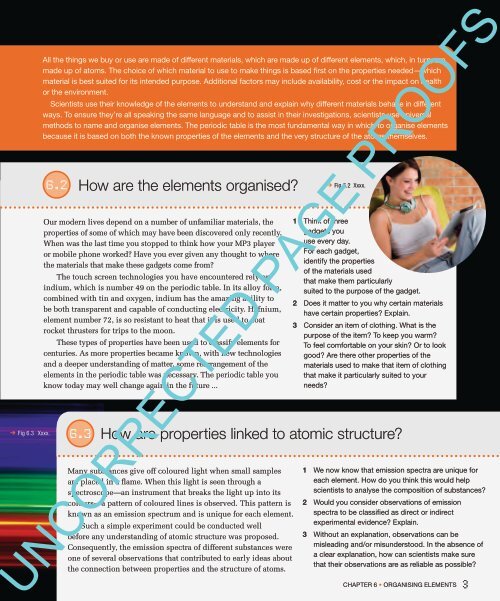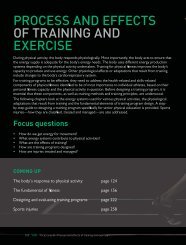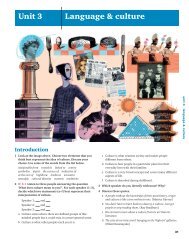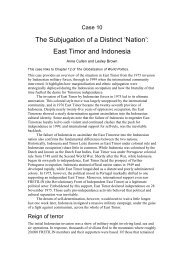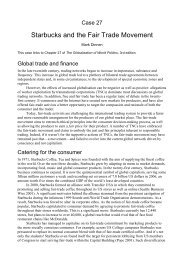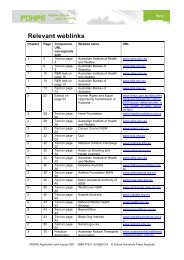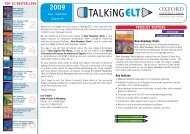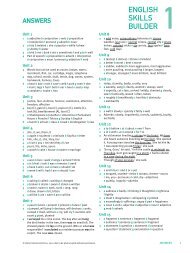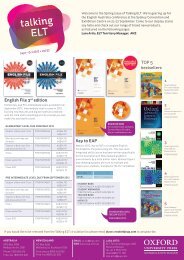2 Chapter 6 ⢠organising elements Organising elements
2 Chapter 6 ⢠organising elements Organising elements
2 Chapter 6 ⢠organising elements Organising elements
You also want an ePaper? Increase the reach of your titles
YUMPU automatically turns print PDFs into web optimized ePapers that Google loves.
Fig 6.3 Xxxx.<br />
All the things we buy or use are made of different materials, which are made up of different <strong>elements</strong>, which, in turn, are<br />
made up of atoms. The choice of which material to use to make things is based first on the properties needed—which<br />
material is best suited for its intended purpose. Additional factors may include availability, cost or the impact on health<br />
or the environment.<br />
Scientists use their knowledge of the <strong>elements</strong> to understand and explain why different materials behave in different<br />
ways. To ensure they’re all speaking the same language and to assist in their investigations, scientists use universal<br />
methods to name and organise <strong>elements</strong>. The periodic table is the most fundamental way in which to organise <strong>elements</strong><br />
because it is based on both the known properties of the <strong>elements</strong> and the very structure of the atoms themselves.<br />
6.2 How are the <strong>elements</strong> organised?<br />
<br />
Our modern lives depend on a number of unfamiliar materials, the<br />
properties of some of which may have been discovered only recently.<br />
When was the last time you stopped to think how your MP3 player<br />
or mobile phone worked? Have you ever given any thought to where<br />
the materials that make these gadgets come from?<br />
The touch screen technologies you have encountered rely on<br />
indium, which is number 49 on the periodic table. In its alloy form,<br />
combined with tin and oxygen, indium has the amazing ability to<br />
be both transparent and capable of conducting electricity. Hafnium,<br />
element number 72, is so resistant to heat that it is used to coat<br />
rocket thrusters for trips to the moon.<br />
These types of properties have been used to classify <strong>elements</strong> for<br />
centuries. As more properties became known, with new technologies<br />
and a deeper understanding of matter, some rearrangement of the<br />
<strong>elements</strong> in the periodic table was necessary. The periodic table you<br />
know today may well change again in the future ...<br />
6.3<br />
Many substances give off coloured light when small samples<br />
are placed in a flame. When this light is seen through a<br />
spectroscope—an instrument that breaks the light up into its<br />
colours—a pattern of coloured lines is observed. This pattern is<br />
known as an emission spectrum and is unique for each element.<br />
Such a simple experiment could be conducted well<br />
before any understanding of atomic structure was proposed.<br />
Consequently, the emission spectra of different substances were<br />
one of several observations that contributed to early ideas about<br />
the connection between properties and the structure of atoms.<br />
Fig 6.2 Xxxx.<br />
1 Think of three<br />
gadgets you<br />
use every day.<br />
For each gadget,<br />
identify the properties<br />
of the materials used<br />
that make them particularly<br />
suited to the purpose of the gadget.<br />
2 Does it matter to you why certain materials<br />
have certain properties? Explain.<br />
3 Consider an item of clothing. What is the<br />
purpose of the item? To keep you warm?<br />
To feel comfortable on your skin? Or to look<br />
good? Are there other properties of the<br />
materials used to make that item of clothing<br />
that make it particularly suited to your<br />
needs?<br />
How are properties linked to atomic structure?<br />
1 We now know that emission spectra are unique for<br />
each element. How do you think this would help<br />
scientists to analyse the composition of substances?<br />
2 Would you consider observations of emission<br />
spectra to be classified as direct or indirect<br />
experimental evidence? Explain.<br />
3 Without an explanation, observations can be<br />
misleading and/or misunderstood. In the absence of<br />
a clear explanation, how can scientists make sure<br />
that their observations are as reliable as possible?<br />
UNCORRECTED PAGE PROOFS<br />
<strong>Chapter</strong> 6 • <strong>organising</strong> <strong>elements</strong> 3<br />
CAS_SB10_TXT_06_1pp.indd 3<br />
11/11/11 4:58 PM


